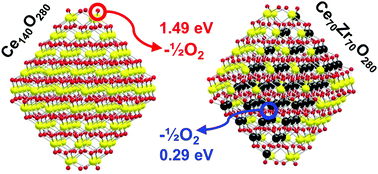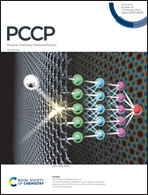Preferential location of zirconium dopants in cerium dioxide nanoparticles and the effects of doping on their reducibility: a DFT study†
Abstract
Structural properties and reducibility of zirconium-doped cerium dioxide systems were studied using periodic plane-wave calculations based on density functional theory. A systematic analysis of the results for nanoparticles of two sizes, Ce40−nZrnO80 ∼ 1.5 nm large and Ce140−nZrnO280 ∼ 2.4 nm large, in comparison with slab model data for Ce1−xZrxO2(111) surface has been performed focusing on specific nanoscale effects. Several loadings of Zr dopants ranging from 0.7 to 50 atomic metal percent have been considered. Subsurface cationic sites of ceria are calculated to be energetically most favourable for doping Zr4+ ions in all models. The system stability with several zirconium ions is defined by the relative stability of the occupied individual Zr4+ positions when only one zirconium ion is present. Data for the Ce70Zr70O280 nanoparticle with an equal number of Ce4+ and Zr4+ cations reveal that atomic orderings of neither separated oxide (Janus-type) particles nor randomly intermixed ones are more stable than the distribution of Zr atoms occupying all cationic positions inside the nanoparticle to minimize the presence of surface zirconium. The basicity of surface oxygen centers in nanoparticles is predicted to be decreased when Zr dopants are located in surface positions. The presence of Zr4+ dopants in CeO2 systems can notably lower the oxygen vacancy formation energy and shows interesting peculiarities at higher Zr loadings. Among them is the higher stability of inner oxygen vacancies in Zr-containing nanoparticles and enhanced oxygen mobility beneficial for application in catalysis and as a solid electrolyte with oxygen ions as charge carriers. Similar to pure ceria, Zr-doped ceria nanoparticles exhibit notably higher reducibility than the corresponding extended systems.



 Please wait while we load your content...
Please wait while we load your content...